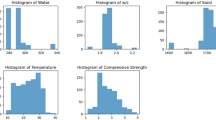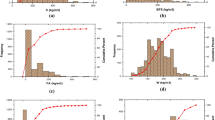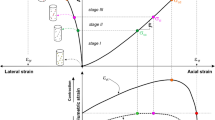Abstract
In recent times, the use of machine learning techniques has become a new trend for predicting compressive strength of concrete. The use of such algorithms in predicting the strength and its proportioning has eased the manual work of mix design. In the present study, an attempt has been made to use advanced machine learning algorithms in predicting concrete strength. It has been performed using ensemble machine learning methods such as random forest regressor and Categorical Boosting (CatBoost) algorithm to predict the compressive strength of concrete. To reduce the underfitting or overfitting issue, a fivefold cross-validation technique has been used. In addition, a comparison has been made between both the algorithms considering performance indices, accuracy, and data importance. Furthermore, by considering different algorithms, the feature importance of each variable and the relationships between variables have been established for making the models more efficient. The analysis of the study exhibits that the random forest and CatBoost have a prediction accuracy of 89.3 and 95.8%, respectively. Thus, considering the accuracy and performance indices, CatBoost model has outperformed random forest model. Finally, this study demonstrates the possibilities of making the infrastructure sustainable and predictable, by analysing the mechanical properties of concrete using different machine learning algorithms.








Similar content being viewed by others
Data availability
The data that support the findings of this study are available in UCI Machine Learning Repository at https://archive.ics.uci.edu/ml/index.php. These data were derived from the following resources available in the public domain:—Concrete Compressive Strength Data Set, 1998, https://archive.ics.uci.edu/ml/datasets/concrete+compressive+strength.
References
Asif Bin Kabir, M., Sajid Hasan, A., & Muntasir Billah, A. H. M. (2021). Failure mode identification of column base plate connection using data-driven machine learning techniques. Engineering Structures, 240(April), 112389. https://doi.org/10.1016/j.engstruct.2021.11238
Asteris, P. G., Koopialipoor, M., Armaghani, D. J., Kotsonis, E. A., & Lourenço, P. B. (2021). Prediction of cement-based mortars compressive strength using machine learning techniques. Neural Computing and Applications. https://doi.org/10.1007/s00521-021-06004-8
Chakraborty, D., Awolusi, I., & Gutierrez, L. (2021). An explainable machine learning model to predict and elucidate the compressive behavior of high-performance concrete. Results in Engineering, 11, 100245. https://doi.org/10.1016/j.rineng.2021.100245
Chou, J. S., Tsai, C. F., Pham, A. D., & Lu, Y. H. (2014). Machine learning in concrete strength simulations: Multi-nation data analytics. Construction and Building Materials, 73, 771–780. https://doi.org/10.1016/j.conbuildmat.2014.09.054
Cihan, M. T. (2019). Prediction of concrete compressive strength and slump by machine learning methods. Advances in Civil Engineering. https://doi.org/10.1155/2019/3069046
Dorogush, A. V., Ershov, V., & Gulin, A. (2018). CatBoost: Gradient boosting with categorical features support, pp. 1–7.
Feng, D. C., Liu, Z. T., Wang, X. D., Chen, Y., Chang, J. Q., Wei, D. F., & Jiang, Z. M. (2020). Machine learning-based compressive strength prediction for concrete: An adaptive boosting approach. Construction and Building Materials, 230, 117000. https://doi.org/10.1016/j.conbuildmat.2019.117000
Güçlüer, K., Özbeyaz, A., Göymen, S., & Günaydın, O. (2021). A comparative investigation using machine learning methods for concrete compressive strength estimation. Materials Today Communications. https://doi.org/10.1016/j.mtcomm.2021.102278
Kaveh, A., & Iranmanesh, A. (1998). Comparative study of backpropagation and improved counterpropagation neural nets in structural analysis and optimization. International Journal of Space Structures, 13, 177–185.
Kaveh, A., & Khalegi, A. (1998). Prediction of strength for concrete specimens using artificial neural network. Asian Journal of Civil Engineering, 2(2), 1–13.
Kaveh, A., & Khavaninzadeh, N. (2023). Efficient training of two ANNs using four meta-heuristic algorithms for predicting the FRP strength. Structures, 52, 256–272. https://doi.org/10.1016/j.istruc.2023.03.178
Khashman, A., & Akpinar, P. (2017). Non-destructive prediction of concrete compressive strength using neural networks. Procedia Computer Science, 108(June), 2358–2362. https://doi.org/10.1016/j.procs.2017.05.039
Lee, S., Nguyen, N. H., Karamanli, A., Lee, J., & Vo, T. P. (2022). Super learner machine-learning algorithms for compressive strength prediction of high performance concrete. Structural Concrete. https://doi.org/10.1002/suco.202200424
Lee, S., & Vo, T. P. (2022). Super learner machine-learning algorithms for compressive strength prediction of high performance concrete. Structural Concrete, 24, 2208–2228. https://doi.org/10.1002/suco.202200424
Ling, H., Qian, C., Kang, W., Liang, C., & Chen, H. (2019). Combination of support vector machine and K-fold cross validation to predict compressive strength of concrete in marine environment. Construction and Building Materials, 206, 355–363. https://doi.org/10.1016/j.conbuildmat.2019.02.071
Mai, H. V. T., Nguyen, T. A., Ly, H. B., & Tran, V. Q. (2021). Prediction compressive strength of concrete containing GGBFS using random forest model. Advances in Civil Engineering. https://doi.org/10.1155/2021/6671448
Mangalathu, S., Jang, H., Hwang, S. H., & Jeon, J. S. (2020). Data-driven machine-learning-based seismic failure mode identification of reinforced concrete shear walls. Engineering Structures, 208(January), 110331. https://doi.org/10.1016/j.engstruct.2020.110331
Nguyen, H., Vu, T., Vo, T. P., & Thai, H. T. (2021). Efficient machine learning models for prediction of concrete strengths. Construction and Building Materials, 266, 120950. https://doi.org/10.1016/j.conbuildmat.2020.120950
Prokhorenkova, L., Gusev, G., Vorobev, A., Dorogush, A. V., & Gulin, A. (2018). Catboost: Unbiased boosting with categorical features. Advances in Neural Information Processing Systems, 2018(Section 4), 6638–6648.
Rathakrishnan, V., Beddu, S. B., & Ahmed, A. N. (2022). Predicting compressive strength of high-performance concrete with high volume ground granulated blast—furnace slag replacement using boosting machine learning algorithms. Scientific Reports. https://doi.org/10.1038/s41598-022-12890-2
Rizvon, S. S., & Jayakumar, K. (2021). Machine learning techniques for recycled aggregate concrete strength prediction and its characteristics between the hardened features of concrete. Arabian Journal of Geosciences. https://doi.org/10.1007/s12517-021-08674-z
Salami, B. A., Olayiwola, T., Oyehan, T. A., & Raji, I. A. (2021). Data-driven model for ternary-blend concrete compressive strength prediction using machine learning approach. Construction and Building Materials, 301(July), 124152. https://doi.org/10.1016/j.conbuildmat.2021.124152
Singh, S. B., Munjal, P., & Thammishetti, N. (2015). Role of water/cement ratio on strength development of cement mortal. Journal of Building Engineering, 4, 94–100.
Verma, M. (2023). Prediction of compressive strength of geopolymer concrete using random forest machine and deep learning. Asian Journal of Civil Engineering. https://doi.org/10.1007/s42107-023-00670-w
Yeh, I. C. (1998). Modeling of strength of high-performance concrete using artificial neural networks. Cement and Concrete Research, 28(12), 1797–1808. https://doi.org/10.1016/S0008-8846(98)00165-3
Young, B. A., Hall, A., Pilon, L., Gupta, P., & Sant, G. (2019). Can the compressive strength of concrete be estimated from knowledge of the mixture proportions: New insights from statistical analysis and machine learning methods. Cement and Concrete Research, 115(December 2017), 379–388. https://doi.org/10.1016/j.cemconres.2018.09.006
Acknowledgements
This work is supported by the NIT Silchar.
Funding
No funding.
Author information
Authors and Affiliations
Contributions
The author involved in all parts of the manuscript preparation.
Corresponding author
Ethics declarations
Conflict of interest
The authors have not disclosed any conflict of interests.
Additional information
Publisher's Note
Springer Nature remains neutral with regard to jurisdictional claims in published maps and institutional affiliations.
Rights and permissions
Springer Nature or its licensor (e.g. a society or other partner) holds exclusive rights to this article under a publishing agreement with the author(s) or other rightsholder(s); author self-archiving of the accepted manuscript version of this article is solely governed by the terms of such publishing agreement and applicable law.
About this article
Cite this article
Sapkota, S.C., Saha, P., Das, S. et al. Prediction of the compressive strength of normal concrete using ensemble machine learning approach. Asian J Civ Eng 25, 583–596 (2024). https://doi.org/10.1007/s42107-023-00796-x
Received:
Accepted:
Published:
Issue Date:
DOI: https://doi.org/10.1007/s42107-023-00796-x




